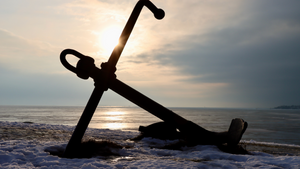The Best Anchor System for Boats
Imagine a summer day on the open water, your boat gently bobbing as you cast out for that record-breaking catch. When it's time to drop anchor and soak in the tranquility, does your vessel hold its position or drift haphazardly? The solidity of this moment, my dear reader, hinges upon one thing: anchoring systems. An unnoticed yet crucial part of any seafaring voyage, right from practical boating to competitive marine sports.
By plunging into the depths of what makes an excellent anchor system for boats, we can protect our peaceful afternoons against unruly tides—and perhaps open up a whole new layer of understanding and enthusiasm towards sailing itself. So whether you're a seasoned sailor or just starting your nautical journey, come aboard! Let's demystify the topic and help you isolate the best anchor system for your boat.

Also Read:
Anchor Systems for Boats: What You Need to Know
Anchors aren't merely heavy objects thrown overboard; they are intricate compositions designed to keep a floating body in place even amidst high winds or strong currents. Different anchors suit different environments—like muddy seabeds or rock-laden waters—and your choice should align with where and how you sail.
Earlier anchor systems comprised three essential parts—a traditional hooked weight, an attached rope (the rode), and human brute force. However, today's industry preference leans toward more sophisticated setups like integrated windlasses - mechanical devices aiding rode retrieval- among others ensuring superior grip and ease of use compared to their old-school counterparts.
Moreover, the efficiency of an anchor system isn't solely reliant on the object at its helm but necessitates appropriate equipment including:
- Anchor line (rode): This is either chain, rope or combination directly attached between the boat and anchor promising tensile strength.
- Connector: Specially shaped links like shackles connect chain and anchor securely.
- Chain Stopper: It stops the chain from running out, acting as a failsafe in case of windlass failure.
With basic knowledge in place, let's navigate towards product recommendation—my top-ranking anchor system— the Cuda Powersports Boat Anchor Kit.

Why the Cuda Powersports Boat Anchor Kit is the Best Anchor System
Navigating through a vast selection of anchor systems could be overwhelming, especially considering the different types and configurations available on the market. Nonetheless, if you're searching for an all-in-one stop solution, there's one anchor system that I believe transcends above others—Cuda Powersports Boat Anchor Kit.
There are several noteworthy advantages that make the Cuda Powersports kit rise above its competition, on which I hope to shine some light.
1. Complete Package
First and foremost, it stands to reason why it earns top marks - Cuda provides you with a comprehensive package inclusive of not just the anchor but all necessary boat anchoring accessories too. From a fluke-style galvanized steel anchor to marine-grade rope, storage bag and buoy ball; rest assured you've got everything covered.
2. High-quality and Durable Components
Not overlooking quality for quantity – each component of this kit has been built to last. The galvanized steel construction offers robustness even in harsh maritime conditions while resisting corrosive wear and tear from salt water exposure.
3. Suitable for Various Bottom Types
Regardless whether your expedition takes you across reef-studded waters or mud-filled coves, this versatile fluke-anchor can hold its ground quite literally onto anything - rocky terrains, weeds, sand or muck; ensuring utmost security.
4. Easy-to-Use Mechanism
Despite being packed with high-tech features such as a quick release mechanism for emergency situations and compact design easy for storage, setting up this rig doesn't require any special skills or expertise, making it suitable even for absolute boating beginners.
While those qualities place Cuda Powersports Boating Anchor at a premier slot when contemplating which anchor system to purchase; do keep in mind that every boating scenario varies intended usage & personal preferences count too. Therefore, a one-size-fits-all solution might not exist but without a doubt, the Cuda Powersports Boat Anchor Kit proves to be an excellent anchor system choice among various options.

Anchor System FAQs:
What is the correct order to anchor a boat?
Anchoring your boat correctly is essential for safe navigation. Follow these steps:
- Select a suitable location clear of other boats and obstacles.
- Approach the area upwind or uptide from where you want your boat to rest.
- Gradually slow down your speed, then turn into the wind or current.
- When in position, stop your motor and lower the anchor until it reaches the seabed.
- Allow reverse drifting with residual momentum, extending the rode as needed.
- Once adequate scope is laid (a commonly-used ratio is 7:1 between length of rode and depth), secure your line.
Remember - always keep watch even after anchoring to ensure you stay secure!
What types of anchor systems are used by sailors?
There several types of anchor systems that sailors rely on based on their requirements and conditions:
- "Deadweight Anchors": Relies solely on weight for holding power.
- "Drag Embedment Anchors": Digs deep into seabed when under load.
- "Buoyant Anchors": Uses buoyancy force to maintain position.
Different scenarios might require different anchors - thus many seasoned sailors have multiple options aboard.
What are the different types of anchors used in boats?
Boat anchors come in diverse shapes and sizes, each suited to specific conditions:
- Fluke anchors are effective for small crafts in sandy or muddy bottoms due to lightweight design offering significant resistance below surface.
- Plow anchors work well over varied terrains but are heavier than fluke ones.
-
Mushroom anchors, ideal for soft sedimentary bottoms, resemble an inverted mushroom providing suction-like grip.
Choose an appropriate type based on anticipated sea-bed composition during anchorage.
What are the different types of anchors? How can someone choose the best one?
Beyond the three basic types previously mentioned, sailors can also use "Grapnel anchors," suited for rocky or coral bottoms, and "Screw anchors" that excel in grassy bottom conditions.
Choosing the right anchor depends on various factors:
- Bottom Condition (sand, mud, rock, etc.)
- The Weight of Your Boat
-
Expected Weather Conditions
Consult an experienced sailor or marine supply store to get advise tailored to your specific scenario.
What is the best type of anchor line for a boat?
A boat's anchor line or 'rode' can be either chain-only, rope-only, or a combination of both (most common). While chains are heavier and more robust than ropes – providing better connection with the seabed – they can strain device windlass compared to using mixed rodes(with adequate snubbing) offering convenience during retrieval besides being cost-effective.
What is a boat anchor winch?
If you're not too excited about manually hauling up heavy anchors, a boat anchor winch is an ideal solution. It's basically a mechanical device that takes care of raising and lowering your anchor at the push of a button.
What are the 4 parts of an anchor system?
An efficient anchor system consists:
- Anchor: Grapples onto the seafloor.
- Rode:Line that connects the vessel with its corresponding anchors(s).
- Connector: Link joining rode with anchor - usually shackles.
- Chafe protection elements: Added to prevent wear and tear on high-stress parts(like over bow chock).
Having these components functioning optimally ensures secure anchorage.
How much anchor line should you use if the water is 20 feet deep?
The length of your "scope"—ratio between depth of water(bottom-to-waterline measurement plus tide height) and overall rode length—impacts anchoring efficiency. Scope-ratios of 7:1 or even 10:1(in case of high winds) get recommended often. Thus for 20-feet deep waters - accounting average tides, deploy anything between 140-200 feet anchor line considering the variables affecting your anchoring conditions

